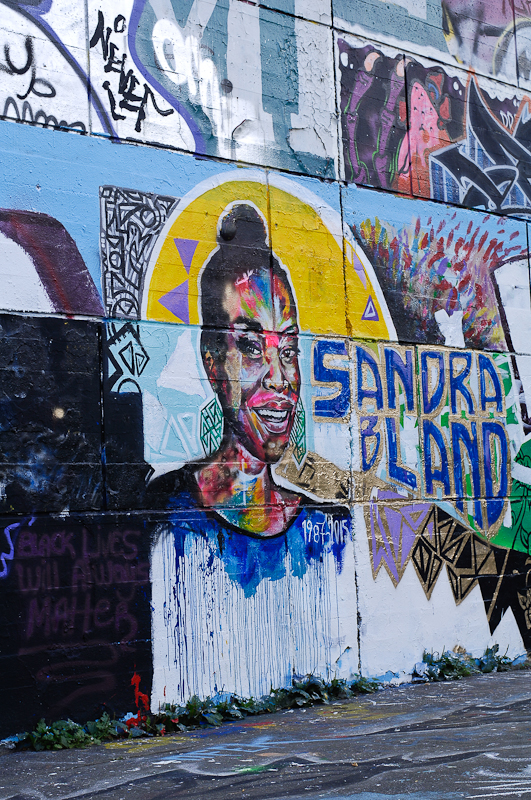Members of Ottawa groups BlakCollectiv and Black Lives Matter (BLM) Ottawa worked together to create a mural declaring “Black Lives Matter” at a public graffiti wall on Slater, known as the Tech wall, earlier this July. A second mural was created in another collaboration as a tribute to Sandra Bland.
The Black Lives Matter mural was the brainchild of BlakCollectiv member Adae B.
She said it was a response to “waking up every day and finding out that another black person has been shot or killed somewhere in the world and having to deal with that every day.”
BLM co-founder R.J. Pate said a group of about 30 people helped create the mural. The wall was painted white with the traces of the paintings underneath visible through the letters.
He said the night the mural was first created, he and his friend were followed by people who were “yelling very arrogant, racist things at us down the street. It was very surreal.”
The mural caused tension among regular graffiti artists at the Tech wall. First it was covered in tags and a message telling BlakCollectiv to “stay off.” Later it was completely hidden by a large piece reading “Wu-Tang is for the children.”
Sentiments criticizing the mural and arguments about graffiti artist etiquette were common in social media comments about BlakCollectiv’s project.
“You were able to organize a few people to paint over a wall, and other people’s work; yet you were unable to organize a group of artists to create something appropriate to your message? I hate to use the term lazy, buuuuuut . . .” wrote Alejandro Almendrades on the BlakCollectiv Facebook page.
BlakCollectiv responded to the defacement of the first mural by working with artists Kalkidan Assefa and Allan Andre to paint a memorial for Sandra Bland, a black woman who died in a Texas jail cell July 13 after being stopped by the police for a traffic violation.
Assef told CBC that he wanted the mural to be “a celebration of her life and spirit.”
By Monday the Sandra Bland mural had also been defaced. The image of Bland’s face was covered with a moustache, and the words “All Lives Matter” were written across the painting.
The defacement was discovered around 1:30 a.m. July 28, and by 3:30 a.m. community members associated with BLM and BlakCollectiv had restored the mural.
Pate said while the defacement itself was an act of racism and specifically “an attack on black women,” he was excited to see the way people mobilized to restore the painting after it was damaged.
He said the defacement opened up a discussion about race in Ottawa that he’s never seen before.
Adae B said the defacement has “been very revealing of the general hushed up nature of racism in Ottawa.”
Both Adae B and Pate said they believe this incident is indicative of a larger problem in Canada’s capital—the suppression of the voices of people of colour.
For example, in May, Bank Street pinball arcade House of Targ garnered criticism after booking the band Black Pussy.
House of Targ published a response to the controversy which said “It is important to realize that a band name that some people find offensive does not automatically make a band racist or [misogynist].”
“I think there’s a very big problem with people being very comfortable and not wanting that comfort to be disturbed, even if it’s at the expense of some of the people surrounding them,” Adae B said of the response.
The band’s name is part of a long history of race-focused misogyny directed specifically at women of colour, according to Pate. While the story also received media attention, he said he thinks it wasn’t talked about nearly enough.
He said while the defacement of the murals has attracted media attention from large outlets such as CBC, Buzzfeed, and the Huffington Post, the voices of the most marginalized members of Ottawa’s non-white community still go unheard.
“I was on the radio with Ed Hann 1310 News and I was like ‘people of colour aren’t being heard,’ and he was like ‘well, you’re being heard now,’ and I lost it . . . I am a black cis man in this community and I give you black women’s voices, emails and contact information and you refuse to talk to them. So no, we’re not being heard,” Pate said.
At a recent panel at Pressed Cafe, several women of colour addressed the challenges faced by them in the arts scene.
“You’re treated poorly because you’re of colour and then you’re treated poorly because you’re a woman,” explained panelist Willow Cioppa. “Once you’re a person of colour as well, you’re faced with problem on problem on problem that you can’t untie.”
Adae B said that as a group comprised mostly of women, BlakCollectiv’s aim is to make those marginalized voices heard.
“As eight black women living in this world as we do, walking through this world dealing with . . . rape, racism, sexism and homophobia . . . we just want the conversation to be on top,” she said. “It’s just a matter of people being ready to listen.”






